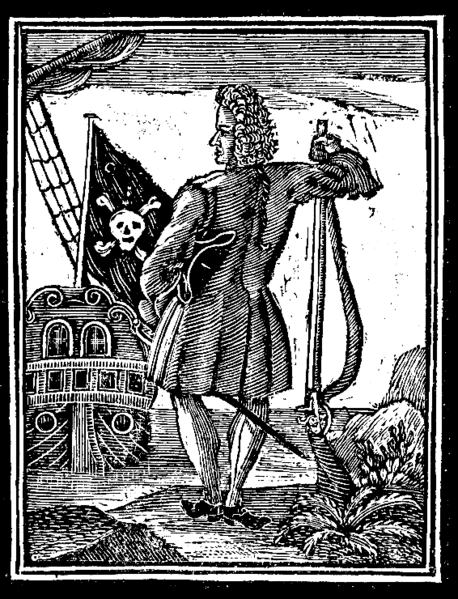
As early as 1724 images of pirate flags appeared in books on piracy. This engraving appeared in The History and Lives of all the Most Notorious Pirates and their Crews, first published in 1734. The pirate is Stede Bonnet. The Jolly Roger shown is similar to that of Worley.
The historical significance: The engraving suggests that as early as 1734, the skull and crossbones flag was synonymous with piracy.
Did the pirates really fly a Jolly Roger?
You bet, or a variation of it. There are many legends about the background of the Jolly Roger (also known as Captain Death among pirates.) One of the most popular myths is that plague ships would fly a black flag to warn others to stay away. This plague flag became a black flag with a white cross that somehow mutated to a skull and crossbones on a back ground of black. The pirates began flying this flag as a way to keep prying eyes away. Eventually everyone caught onto the scheme.
There is also the belief that Jolly Roger is from the eastern pirates. The Chiefs of Cannonore were notorious pirates had the Tamil title Ali Raja, meaning King of the Sea. They also flew a red jack or flag.
At least one source claims that the name was first given to the flag of Bartholomew "Black Bart" Roberts.
Yet another account attributes the Buccaneers for the name. However, it is clear that buccaneers sailed as privateers for England and as such sailed under a national flag and not the Jolly Roger (at least not always). Buccaneers would often raise a red flag along with their national flag when calling on a ship to surrender. The red flag, simply put, meant that no quarter would be given if a ship offered resistance. This flag was called joli rouge and would have easily been corrupted into English as the Jolly Roger. The name transferred when the flag switched from red to black.
But a quick search of the Oxford English Dictionary reveals that as early as 1724, Old Roger was a British term for the Devil and as early as 1540 a "roger" was a begging vagabond. Roger was a corruption of "rogue". So it might be that it was just slang for the vagrants of the sea or a "jolly roger". Finally by 1785, Francis Grose defines Jolly Roger as a pirate flag in his work A Classical of the Vulgar Tongue.
The flag or "jack" was an important part of sea life. Ship would hoist their national flag or Ancient when approaching other vessels to ward off enemy and attract friends. Many ships had and still have a battle jack which is raised as a sign that they are going into battle. Pirates might have flown a national flag or perhaps hoisted another nation's flag in order to get in close to another ship. Once in close the Jolly Roger would be quickly hoisted as a battle flag at the moment of engagement. The Jolly Roger was also a symbol that meant no quarter would be given if a battle ensued. Quite often this was more bluff than truth.
Flag or Jack? Confused. Don't be!
A jack is a ship's flag of smaller size than the ensign, used at sea as a signal, or as a mark of distinction; Around the time of Golden Age of Piracy it was the small flag flown at the sprit-sail, topmast head. Today it is more commonly flown from the jack-staff at the bow of a vessel. It typically indicates the nationality of a ship, as in British jack, Dutch jack, French jack, etc. Most of the time any type of national color was referred to as a nation's ancient or colors.
Pirates, not belonging to any nations would often make up their own personal flag or jack so as to spread their infamy.
Because ships needed to signal each other from great distances, many ship's (even non-pirate ships) had distinctive flags for identification. Even today, the flagship is the flag bearing the admiral's flag. The flag transfers from ship to ship with the admiral. thus any ship in the fleet can be the flag ship so long as the Admiral of the fleet is aboard.
However, it should be known that all navies were known to fly false colors as a ruse to get close enough to attack. This was actually considered fair and proper so long as the ship attacked under true colors. Almost all navies carried a variety of flags from friendly, enemy and neutral countries. It wasn't just a pirate ruse. For the most part, ships used a variety of measures to determine if a ship was friend or foe, including, type of ship, type of sail, flags flown and even identification of individuals on board. Even after getting positive identification the good captain would still approach with utmost caution.

Flags of Famous Pirates
Many pirates had custom flags that were quite different from the standard skull and cross bones on a background of black. The following are a few of the flags that were flown by various pirates, privateers and buccaneers, along with a brief description.
It must be noted, that quite often the wrong jacks have been attributed to different pirates. The jacks listed here, unless otherwise stated have been verified by at least three different sources. If a jack is suspect, in that I have only found one or two sources or I have found several contrary sources, it will be so noted in the text.
Sir Henry Morgan and the Buccaneers
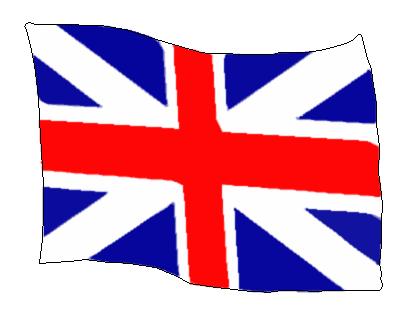
Sir Henry Morgan and the Buccaneers
Actually Captain Henry Morgan, for he was not knighted until his days of privateering were over. Morgan flew under papers from King Charles of England, hence he flew one of the most dreaded jacks of piracy known to the Spanish Main. It is quite possible that his crew would have used a buccaneers joli rouge as well because most of Morgan's men were buccaneers and freebooters from Jamaica and other Caribbean islands.
Morgan did indeed commit at least one act of piracy. When he sacked Panama, England was at peace with Spain. Morgan was well aware of this, however he felt that Jamaica was not safe so long as Spain had forces in the Caribbean. The Governor of Jamaica was obliged to arrest Morgan, for whom he had great displeasure and. Morgan was sent to England in chains but as usual, by the time the sea voyage was done, England was once again threatening war with Spain, and Morgan was knighted for his bravery and returned to Jamaica as Lieutenant Governor. One can also assume that King Charles was given a handsome sum of gold from Morgan's exploits in Panama. Quite often the crown would receive ten to fifty percent of any plunder.
Joli Rouge
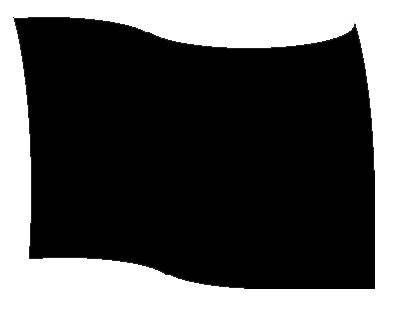

Buccaneers Jacks (Joli Rouge)
According to some sources, the Jolly Roger began life as a simple red jack flown by buccaneers. The red jack was called the joli rouge by the buccaneers. a literal translation of the term would be "lovely red flag" but the term did not translate literally instead it translated phonetically to " jolly roger".
The joli rouge was hoisted as a sign that no quarter would be given if resistance was met. The flag transmuted into the universal flag of "death" that being a solid black flag.
Still another source says that the black flag was raised as sign that a ship was to be attacked and if they struck their colors and surrender no harm would come to the ship. After waiting a few minutes for an answer, if no answer was given, the pirates would raise the red flag (joli rouge) in addition to the black flag, meaning that the time for deliberation was over and now no quarter would be given if the enemy resisted.
John Avery (Henry Every, Long Ben)
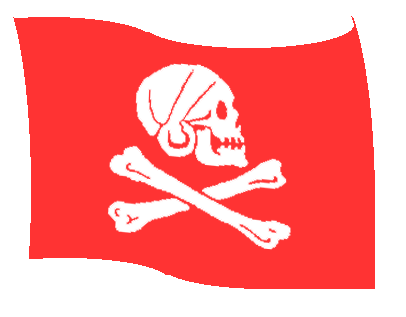
This flag is often attributed to John Avery but is probably a product of 20th Century imagination.
Supposedly he first flew a red flag but during his career he switched to a black one. John Avery was the subject of play written by Charles Johnson. The Successful Pirate, written in 1712 gave a glamorized account of Avery.
If the flag were truly that of the real John Avery, it would be earliest of the known skull and crossbones. Avery began his sojourn of piracy in 1694 when he helped a crew of Spaniards mutiny. After being elected captain he re-christened the ship Fancy. The "successful pirate" concluded his roving days, avoiding the gallows. However, in the end Avery died in Bristol, England completely poor and destitute.
Captain Richard Worley (Robert Worley)
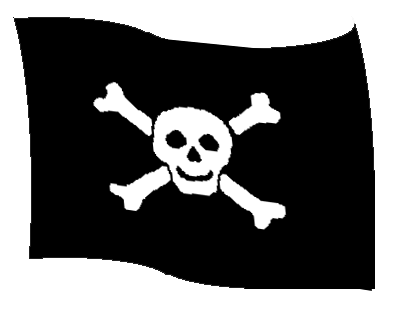
His was a short career! However in the area of pirate flags, Worley's may have been trend setter. He started his short lived adventure in September 1718 and it ended in February 1719. Some sources claim that his crudely drawn skull superimposed over crossed bones was the first true jolly roger of its kind.
As with most pirates, Worley was caught in a trap set by the British Navy. While his small crew fought to the end, Worley and one other pirate managed to live long enough to be hanged a day after the engagement. Worley's career started in New York and ended in North Carolina. It is uncertain if he ever made it to the Spanish Main as a pirate but he served with Buccaneers during Queen Anne's War.
John Quelch
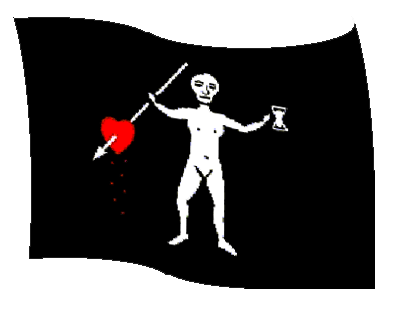
In 1703, John Quelch set off on the Privateer, Charles but shortly after leaving the dock, tossed the captain overboard and headed to the South Atlantic, on the account. Not long afterwards he came upon a Portuguese gold ship and robbed her. He wasn't concerned that Portugal and England were at peace at the time. Shortly there after he was brought back to Maine and entertained the locals by being hanged and buried between the tides.
His flag is sometimes considered the first known jolly roger, which would contradict the Avery claim. It features an "anatomy" with hour glass and pierced heart. The theme was later borrowed by Blackbeard and Bartholomew "Black Bart" Roberts.
Captain Edward England
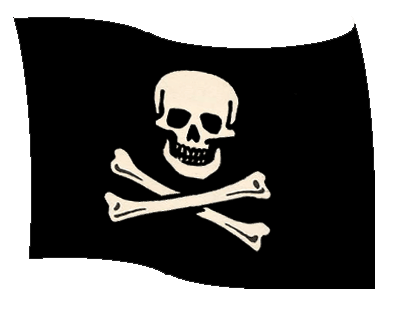
England is the earliest recorded jack to be a skull displayed above the crossed bones. (see Worley by comparison) A few sources claim his as the only flag of such type but this is not the case. Most pirate flags were either based on England's or Worley's pattern.
England began his days as a pirate in the Caribbean but after turning down a pardon in the Bahamas set about becoming the terror of Africa and Madagascar. It is said he had a wooden leg and unruly beard and was the inspiration of the fictional Long John Silver. His career dates from around 1720.
Calico Jack Rackham
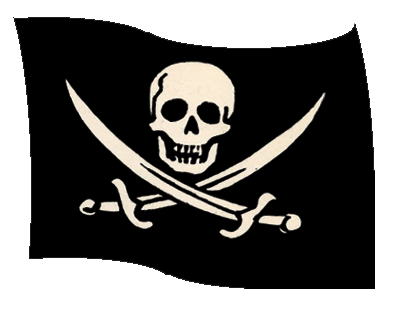
Calico Jack Rackham was a flamboyant pirate and no ordinary jack would have suited his purpose. He devised a jack which consisted of a skull with crossed cutlasses on a black background. But in the end he he was cornered by a British sloop-of war- and after short fight he and his crew hid below decks like scurvy dogs. Anne Bonny, his lover and one of his crew was so sickened by this act of cowardice that when Rackham was to be hanged, She could only comfort him by saying, "If you would have fought like a man you needn't die like a dog."
Calico Jack's flag was resurrected by Hollywood for the movies Cutthroat Island and Pirates of the Caribbean: Curse of the Black Pearl. It is quickly becoming more common place in movies than the traditional skull and crossbones.
Stede Bonnet
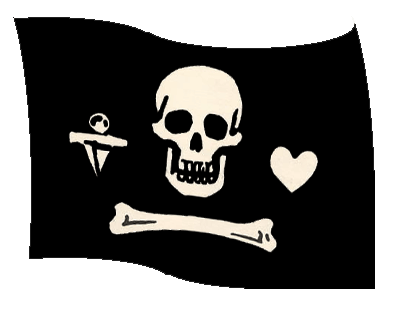
It is rumored he was driven to piracy by a nagging wife. Bonnet was a land owner and fairly respected man. He bounced back and forth from privateer to piracy until the gallows caught up with him. His flag consisted of a dagger on one side of skull and heart on the other. A single bone lay horizontal under the grinning death's head. What did it all mean? The skull obviously meant that the he was a pirate. The bone was a balance between life (a heart) and death (the dagger). The choice was yours. Bonnet primarily sailed the Carolina coast.
Blackbeard (Edward Teach, Edward Thatch)
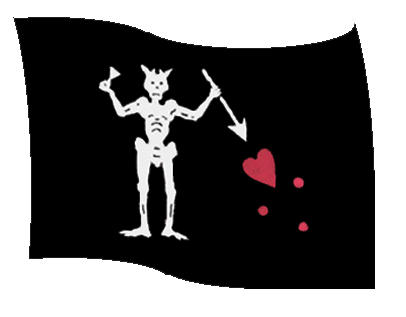
He began his sailing life as a privateer out of Jamaica. It wasn't long before he decided he should keep it all and given only the devil his due. He held the city of Charleston hostage for medicine for his ailing crew. He was a blood thirsty killer who was known to kill members of his own crew for sport. He wound up dead when he took on a British man-o-war.
As with many jacks, Blackbeard's presented a warning. In this case we have an "anatomy" of the devil piercing a heart while holding an hour glass. Many pirates flew flags with an "anatomy" represented. Most often the anatomy refers to drawing of full body such as a skeleton, but occasionally anatomy refers to a nude man or a man wearing clothes.
Ned Low (Edward Low, Lowe, Loe)
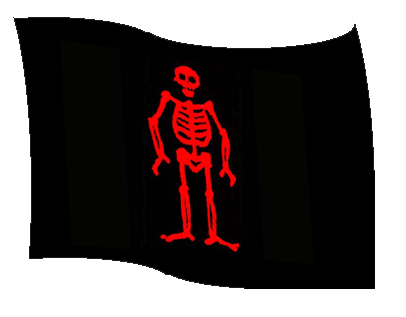
The somewhat remarkable and very bloodthirsty Edward Low operated all about the Atlantic, having a particular dislike for New Englanders. He enjoyed torturing his captives and it was the rare soul who lived once being taken upon Low's ship.
His career may have needed around 1724 but no one knows for sure. He was last seen off the coast of Africa after deserting a fellow pirate captain to the mercies of the Royal Navy.
Lowe fancied his ships with a red "anatomy" on a black flag.
Captain Emanuel Wynne
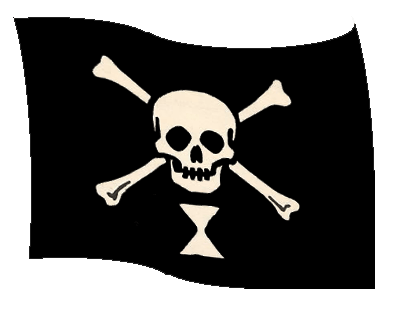
The French pirate Emanuel Wynne is also claimed to have flown the first jolly roger. Wynne started his career in the Carolinas around 1700. Avery's red flag was flying around the same time as was Quelch's flag with a full anatomy. It is hard to imagine that all three men, coming from different port came up with the same idea at the same time. most likely the skull and crossbones motif dates from a still earlier time and the true "first jolly roger" is lost to history.
Wynne's flag closely resemble's Worley's but has the addition of an hour glass under the skull. The hour glass is a sign that "time for deliberation is short or is running out".
Bartholomew (Black Bart) Roberts
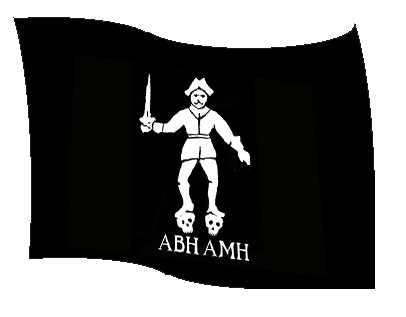
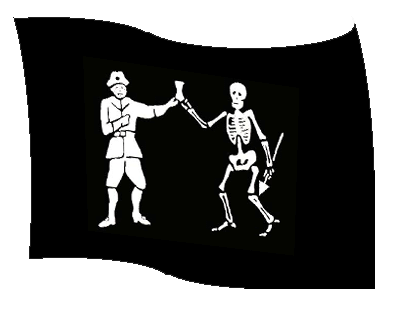
Some claim his flags were the first to be called jolly roger. Black Bart sailed from 1719 to 1722 as a pirate. He plied his trade in the Atlantic.
He was known to fly at least two flags and possibly as many as four. The one on the left has Black Bart standing on the skulls of "ABH and AMH", A Barbados Head and A Martinique's Head. The Governors of the two islands had hired pirate hunters to chase Roberts and in response Roberts was especially ruthless toward anyone from those islands.
Another well known flag of Roberts has him sharing a cup of wine with the Devil or death.
Bart was known to be a tea-totaler who abhorred gambling and smoking and found time to preach to his crew on Sunday. Many believe him to be the most successful of all the pirates during the Golden Age of Piracy.
He was eventually cornered and killed off the coast of Africa. His crew honored his last wishes and dumped his body overboard so that he would not be taken prisoner alive or dead.
Captain Thomas Tew
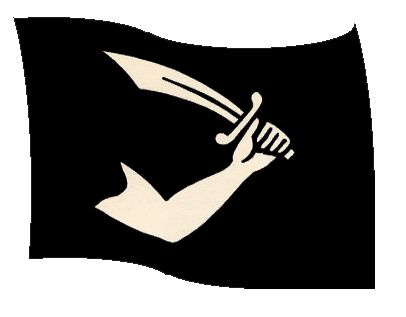
Another pirate dating from the end of the 1600s. His flag did not have a skull or even a bone. Just an arm wielding a cutlass or scimitar.
Tew was quite successful and seemed to roam freely throughout the Atlantic, Mediterranean and even Red Sea. most accounts claim he joined the brethren in Rhode Island and became quite successful. The end of Thomas Tew occurred around 1695 during a sea battle. From most accounts his belly was ripped apart by sangrenel[1] and as his intestines fell out upon the deck of the ship and he lay writhing in the final gasps of his life, his crew became so terrified by the sight that they struck their colors and gave up without another shot being fired.
A similar event occurred when Black Bart was killed. Such was the power and awe that these captains held over their men.
[1] Sangrenel — A type of case round consisting of scrap iron and other waste materials.

The only author and editor of all pages on the site. Most of what I write about is based on years of book reading on the topic. My first web page was published back in 1994.